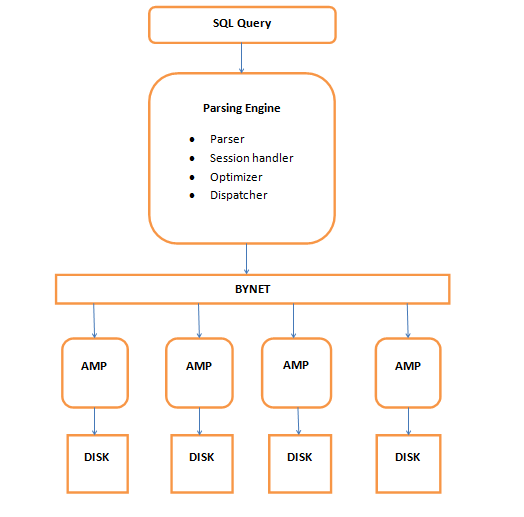The main components of Teradata Architecture are PE(Parsing Engine), BYNET, AMP(Access Module Processor), Virtual Disk. Following is the logical view of the architecture:  Parsing Engine
Parsing Engine
When a user fires an SQL query it first gets connected to the PE (Parsing Engine). The processes such as planning and distributing the data to AMPS are done here. It finds out the best optimal plan for query execution. The following are the processes performed by PE:
- Parser: The Parser checks for the syntax, if true forward the query to Session Handler.
- Session Handler: it does all the security checks, such as checking of logging credentials and whether the user has permission to execute the query or not.
- Optimizer: It finds out the best possible and optimized plan to execute the query.
- Dispatcher: The Dispatcher forwards the query to the AMPs.
BYNET
The BYNET acts as a channel between PE and AMPs. It acts as a communicator between the two. There are two BYNETs in Teradata ‘BYNET 0’ and ‘BYNET 1’. But we refer them as single BYNET system. The reason for having 2 BYNETs is:
- If one BYNET fails, the second one can take its place.
- When data is large, both BYNETs can be made functional which improves the communication between PE and AMPs, thus fastening the process.
AMP
Access Module Processor is a virtual processor which is connected to PE via BYNET. Each AMP has its own disk and is allowed to read and write in its OWN disk. This is called as ‘SHARED NOTHING ARCHITECTURE’. When the query is fired , Teradata distributes the rows of table on all the AMPs and when it calls for any data all AMPs work simultaneously to give back the data. This is called PARALLELISM. The AMP executes any SQL requests in three steps
- Lock the table.
- Execute the operation requested.
- End the transaction.
Disk
Teradata offers a set of Virtual Disks for each AMP. The storage area of each AMP is called as Virtual Disk or Vdisk. The steps for executing the query are below:
- The user fires the query which is sent to PE.
- PE does the security and syntax checks, and finds out the best optimal plan to execute the query.
- The table rows are distributed on the AMP and the data is retrieved from the disk.
- The AMP sends back the data through BYNET to PE.
- PE returns back the data to the user.
